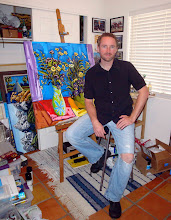 This week I have just finished a new painting of an orange tree dangling over Oak Creek in Sedona. A heavy, colorful piece that has all the peculiarity of one of my works - where even the water or the leaves give off the feeling of weighing a hundred tons.
This week I have just finished a new painting of an orange tree dangling over Oak Creek in Sedona. A heavy, colorful piece that has all the peculiarity of one of my works - where even the water or the leaves give off the feeling of weighing a hundred tons.Those who have read my blogs will know that I am a great appreciator of what seem to me to be true and powerful artistic statements, even if the aritsts in question are not oil painters or visual artists. I've long admired the Candyland-like fantasies of the architect Gaudi. And among a legion of amazing artists that I admire and respect are found countless musicians. One of which stands alone, The Doors.
The first and most obvious thing about The Doors is the persistence and the longevity of the music that they created. "Unknown Soldier" could tell the story of an American soldier in Afghanistan just as well as its implied references to soldiers and the militarism and violence of the Vietnam era. The cry "What have they done to the earth? What have they done to our fair sister?" that rings out in "When the Music's Over" could well tell the story of an oil-stained gulf coast beach today. It could well be a statement in agony over the destruction of so many irreplacable natural habitats on our planet.
Timelessness demonstrates the power of an artistic statement. Those statements that are too much a product of the time that they were expressed in tend to dissipate with the passing of that particular time. The music of the Doors is powerful because it is an inter-generational commentary by sensitive individuals, who were deeply concerned with the art of what they were saying. Some regard Jim Morrison as an American poet - and I share this feeling. Though it should not be overlooked that Robbie Krieger wrote some of the Doors' best known songs, most notably the immortal "Light my Fire." If you read Morrison's published notebooks and poems, such as "Wilderness" and "The American Night", then you realize that his sensations and words were not always a product of the rational, but in the images that they created, powerful visions were let loose on the consciousness of those who read them in print - and those who heard them in Doors concerts. Morrison was reported to have said that "real poetry doesn't say anything, it just ticks off the possibilities."
Frequently, when I allowed myself to think about my own paintings in a deeper way - I articulated in my mind a dual standard that I always wanted to strive for. That standard was beauty and originality. I think the Doors and their music also lines up nicely with this idea of a creative aspiration. Of course many of the lyrics and sentiments in the music of the Doors were dark, even darkened Dionysian visions of America and our reality. But I don't count that as ugly - I think that's beautiful. Disturbing images, or even disturbing songs can stir the mind to beauty just as much as an any other cliche of beauty can. And songs like "Summer's Almost Gone" as well as "Crystal Ship" are indeed quite beautiful on the surface. It has seemed to me that the poignant words of Morrison, and the carnavalesque feeling of Ray Manzarek's organ went hand in hand in making songs that could range you for the depths of joy, sadness, confusion, even apocalyptic sensations.
What does the music of the Doors say to artists of all varieties? Primarily, I think it drives home, with punishing insistence, the reality that there really is NO substitute for originality in the creative arts. When you realize how much timeless substance exists in the songs of the Doors, you realize that a true statement of creation - as I've mentioned above, is timeless and inter-generational. So if you wish to hang your hat with the gods of the creative arts - it should be obvious that you ought to aim for the timeless and the original. Take a lesson from the Doors, and the fact that we are still talking about them today.
www.neilmyersart.com

No comments:
Post a Comment